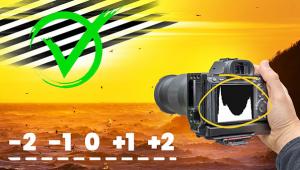The New Zeiss Ikon Rangefinder 35; A Real, Traditional, High-End System Page 2
ZI vs. M2 |
|
 |
|
|
Exposure Compensation
There is, however, a very clever exposure compensation system, again shared
with the R2A/R3A. Either side of the shutter speed index, there are 1/3 stop
gradations running from +2 stops to -2 stops. To dial in any compensation within
this range, simply move the "A" to the appropriate index. The shutter
speed will then flash, to remind you that you have selected compensation. This
allows easy 2/3 stop brackets, arguably the ideal for color slide film because
it gives you an exposure that is within 1/3 stop of perfect across +/-1 stop.
There is a clever, simple autoexposure lock. Press the little chrome button
immediately below the accessory shoe and the speed is locked: the letters AEL
appear at the bottom of the shutter speed column. There's an auto-off
feature if the camera isn't used for a while, or you can turn it off manually
by pressing it again. The button is handy for your thumb. You can still dial
in exposure compensation after setting the AEL.
The eyepiece to the range/viewfinder is rubber-armored (no scratched eyeglasses)
and user interchangeable for dioptric fittings, at $44 each. The fitting is
common to the interchangeable viewfinders and to the Bessa R2A/R3A (and several
old Nikons). One eyepiece (on the 15mm finder) came adrift and had to be screwed
back in; we then noticed that the 25/28 finder was missing its eyepiece, which
had presumably been lost earlier. This does not affect the functionality but
a dab of Loctite or similar might be a good idea.
Another security concern, rather more serious, is the accessory shoe. This is
no tighter than on a Bessa, and distinctly less tight than an MP. Given that
finders are occasionally lost even from Leicas, this is worrying. Consider dipping
viewfinder feet in clear Plasti Dip (www.plastidip.com), which is normally used
to make tools more "grippy."
The standard 1/4" tripod socket at the end of the base plate is set in
a little plinth so that the rewind crank does not tip the camera sideways when
you set it down. The bearing surface around the socket is small but just about
adequate in use. As well as the hot shoe there is a standard PC sync nipple,
and the shutter release accepts a standard PC-tapered cable release. Unlike
current Leicas (but like Bessas) there is a focal plane registration mark on
the ZI.
Because the rewind is on the bottom, it goes counterclockwise (anticlockwise).
Frances had no trouble with this at all, but the first time Roger used it he
wound the wrong way and jammed the film in the cassette. If you are used to
auto-rewind, you'll never notice; if you're used to other manual
rewinds, LOOK AT THE ARROW.
Viewfinder Comparison |
||||
| Taking the Zeiss Ikon as 100 percent, the following are linear
(magnification) variations: + means the other finder showed more, - means
less.
Note: 85mm and 90mm have been lumped together: an asterisk means a 90mm frame. Figures for both distant and close subjects are given for the Tewe and 90mm Voigtländer finder. |
||||
28mm |
35mm |
50mm |
85mm |
|
| Leica M2 | - | 8% | identical | *+3% |
| Leica MP | +3% | +6% | -5% | *identical |
| Voigtländer Bessa R2 | - | +3% | +2% | *+6% |
| Voigtländer Bessa R3A | - | - | +2% | *-3% |
| 25/28 Zeiss finder | +3% | - | - | - |
| 28/35 Voigtländer finder | +3% | - | - | - |
| 28 Voigtländer finder | +6% | - | - | - |
| 90mm Voigtländer finder | - | - | - | *+12/-6% |
| Russian "Turret" finder | +12% |
+10% | - | +9% |
| Tewe 35-200mm finder | - | +7/+5% | +8/+5% | +20/+12% |
Evaluation
So what is the bottom line on the camera? If you are not already committed to
a system, and want a rangefinder camera, the ZI body warrants very serious consideration
indeed. Otherwise, there are three kinds of buyer: those trading up from Voigtländer
(or Rollei), those looking for a second body for a current Leica system, and
those looking for something more modern than an older, non-metered Leica.
As a trade-up, there is no contest. The Voigtländers are good: this is
even better. Frances, who has been using Bessas since they came out, finds the
ZI better in almost every way. It is easier to hold steady; quicker and easier
to load; better in the finder department; and much easier to focus accurately,
thanks to the long rangefinder base. Her only reservation is that she prefers
the "traffic lights" meters in her Bessa-T and Bessa R2.
As a second body in an M-System, the ZI is obviously more of a competitor for
an M7 (exposure automation, battery dependency) than for an MP, but either way
there are significant differences from a Leica, most notably the rewind crank
on the bottom and the meter read-out. These might make it hard to use both an
M-series and a ZI side by side: better, we suspect, to choose one system or
the other.
As for the choice between an older, non-metered Leica (M2-3-4) or a new ZI,
we'd both be inclined to go for the ZI, Roger marginally but Frances without
hesitation.
Ultimately, of course, the only possibility is to get your hands on one and
see if you like it. You'll know within seconds if you do. We'd be
surprised if you don't.
For more information, contact Hasselblad USA Inc., www.hasselbladusa.com.
- Log in or register to post comments

































